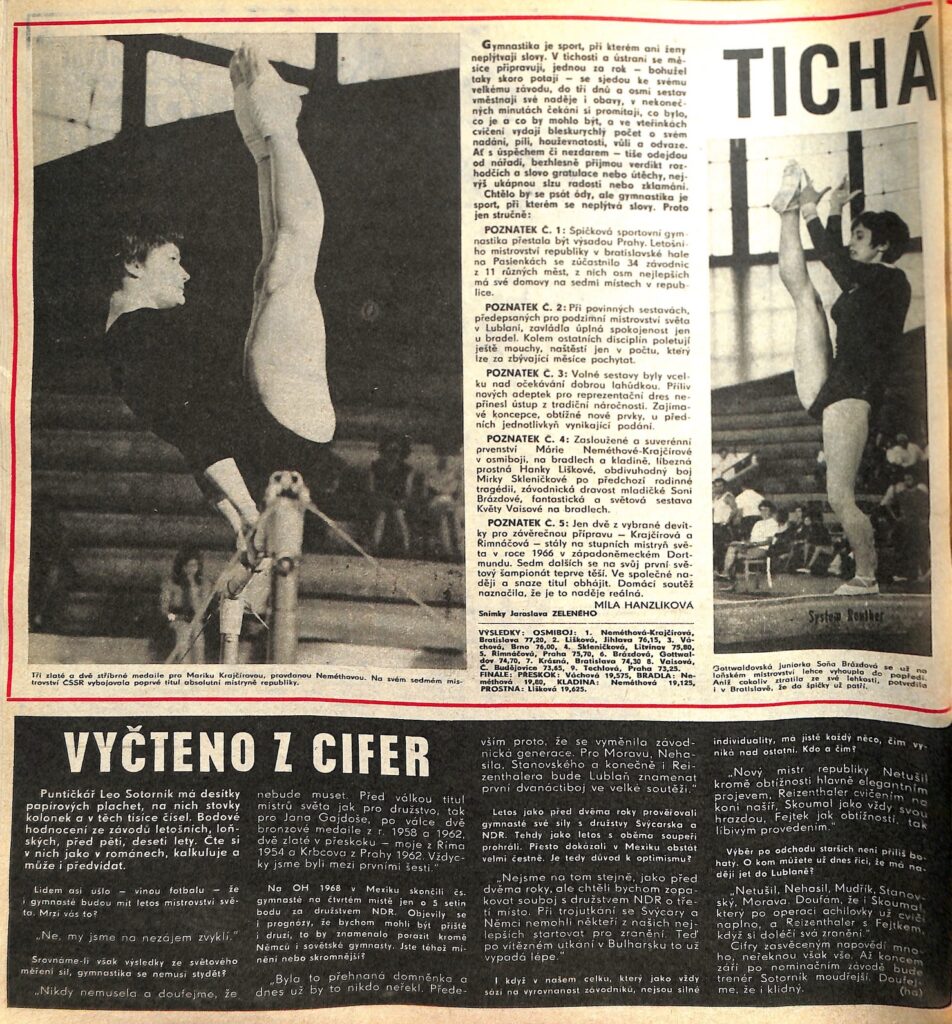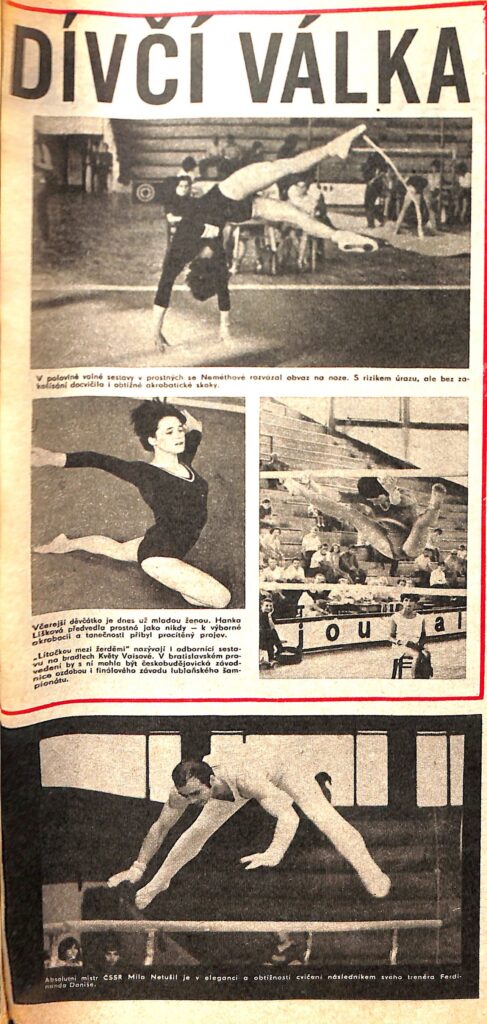1970 was a time of change for the Czechoslovak women’s team. The majority of the gymnasts who won gold at the 1966 World Championships had retired, including Čáslavská. Several of their coaches had also left. Luděk Martschini was coaching the Swiss women’s team, and long-time head coach Jaroslava Matlochová was coaching in Italy.
For the Czechoslovak men, there was some optimism ahead of the World Championships in Ljubljana. After the team finished fourth at the Mexico City Olympics — just 0.05 behind the East Germans — there was some optimism. That said, the Czechoslovak team was going to put together a young, inexperienced team for the 1970 Worlds.
Here’s what was reported in the pages of Stadión after the 1970 Czechoslovak Championships.


The Silent Girl War
Gymnastics is a sport where even women don’t waste words. In silence and seclusion, they prepare for months, once a year — sadly, also almost in secret — they come together for their big competition, they cram their hopes and fears into three days and eight routines, they project in the endless minutes of waiting what was, what is, and what could be, and in seconds of exercise they give a lightning-fast account of their talent, diligence, tenacity, will, and courage. Whether with success or failure, they will quietly walk away from the apparatus, silently accept the verdict of the judges and a word of congratulations or consolation, at most shed a tear of joy or disappointment.
It would be tempting to write odes, but gymnastics is a sport in which no words are wasted. So just briefly:
NOTE No. 1: Top-class sports gymnastics is no longer the prerogative of Prague. This year’s national championships in Bratislava’s Pasienky Hall were attended by 34 athletes from 11 different cities, with the top eight having homes in seven places in the country.
NOTE No. 2: In the compulsory routines prescribed for the autumn World Championships in Ljubljana, there was complete satisfaction only with the uneven bars. The other disciplines remain marred by problems, fortunately only in numbers that can be resolved in the remaining months.
NOTE No. 3: The optional routines were an above-average treat on the whole. The influx of new candidates for the national jersey did not bring a retreat from the traditional difficulty. Interesting concepts, difficult new elements, and for the leading individuals, excellent performances.
NOTE No. 4: Deserved and sovereign first place of Mária Neméthová-Krajčírová in the all-around, on uneven bars, and balance beam, a charming floor exercise by Hana Lišková, admirable fight of Mirka Skleničková after a previous family tragedy, competitive ferocity of young Sonia Brázdová, fantastic and world-class routine of Květa Vaisová on uneven bars.
NOTE 5: Only two of the nine selected for the final preparation — Krajčírová and Řimnáčová — stood on the podium of the 1966 World Championships in Dortmund, West Germany. Seven others are still looking forward to their first world championship. In a shared hope and effort to defend the title. The home competition has indicated that this hope is realistic.
MILA HANZLÍKOVÁ
Pictures by Jaroslav ZELENÝ
RESULTS:
ALL-AROUND:
1. Marianna Neméthová-Krajčírová, Bratislava 77.20,
2. Hana Lišková, Jihlava 76.15
3. Marcela Váchová, Brno 76.00
4. Miroslava Skleničková, Litvínov 75.80
5. Bohumila Řimnáčová, Prague 75.70
6. Soňa Brázdová, Gottwaldov, 74.70
7. Luba Krásná, Bratislava 74.30
8. Květa Vaisová, Č. Budějovice 73.65
9. Jarmila Techlová, Prague 73.25.FINALS
Stadión, July 9, 1970
VAULT: Váchová 19.575
UNEVEN BARS: Neméthová 19.60
BALANCE BEAM: Neméthová 19.125
FLOOR EXERCISE: Lišková 19.625.
Tichá dívčí válka
9. července 1970
Gymnastika je sport, při kterém ani ženy neplýtvají slovy. V tichosti a ústrani se měsíce připravují, jednou za rok — bohužel taky skoro potají — se sjedou ke svému velkému závodu, do tři dnů a osmi sestav vměstnají své naděje i obavy, v nekonečných minutách čekáni si promítají, co bylo, co je a co by mohlo být, a ve vteřinkách cvičeni vydají bleskurychlý počet o svém nadáni, píli, houževnatosti, vůli a odvaze. Ať s úspěchem či nezdarem — tiše odejdou od nářadí, bezhlesně přijmou verdikt rozhodčích a slovo gratulace nebo útěchy, nejvýš ukápnou slzu radosti nebo zklamáni.
Chtělo by se psát ódy, ale gymnastika je sport, při kterém se neplýtvá slovy. Proto jen stručně:
POZNATEK Č. 1: Špičková sportovní gymnastika přestala být výsadou Prahy. Letošní ho mistrovství republiky v bratislavské hole na Pasienkách se zúčastnilo 34 závodnic z 11 různých měst, z nich osm nejlepších má své domovy na sedmi místech v republice.
POZNATEK Č. 2: Při povinných sestavách, předepsaných pro podzimní mistrovství světa v Lublaní, zavládla úplná spokojenost jen u bradel. Kolem ostatních disciplín poletují ještě mouchy, naštěstí jen v počtu, který lze za zbývající měsíce pochytat.
POZNATEK Č. 3: Volné sestavy byly vcelku nad očekávání dobrou lahůdkou. Příliv nových adeptek pro reprezentační dres nepřinesl ústup z tradiční náročnosti. Zajímavé koncepce, obtížné nové prvky, u předních jednotlivkyň vynikající podání.
POZNATEK Č. 4: Zasloužené a suverénní prvenství Márie Neméthové-Krajčírové v osmiboji, na bradlech a kladině, líbezná prostná Hanky Liškové, obdivuhodný boj Mirky Skleničkové po předchozí rodinné tragédii, závodnická dravost mladičké Soni Brázdové, fantastická a světová sestava Květy Vaisové na bradlech.
POZNATEK Č. 5: Jen dvě z vybrané devítky pro závěrečnou přípravu — Krajčírová a Řimnáčová — stály na stupních mistryň světa v roce 1966 v západoněmeckém Dortmundu. Sedm dalších se na svůj první: světový šampionát teprve těší. Ve společné naději a snaze titul obhájit. Domácí soutěž naznačila, že je to naděje reálná.
MILA HANZLÍKOVÁ
Snímky Jaroslava ZELENÉHO
VÝSLEDKY: OSMIBOJ: 1. Neméthová-Krajčírová, Bratislava 77,20, 2. Lišková, Jihlava 76,15, 3. Váchová, Brno 76,00, 4. Skleničková, Litvínov 75,80, 5. Řimnáčová, Praha 75,70, 6. Brázdová, Gottwaldov, 74,70, 7. Krásná, Bratislava 74,30 8. Vaisová, Č. Budějovice 73,65, 9. Techlová, Praha 73,25.
FINALE: PŘESKOK: Váchová 19,575, BRADLA: Neméthová 19,60, KLADINA: Neméthová 19,125, PROSTNA: Lišková 19,625.
READ FROM THE NUMBERS
Leo Sotorník, a stickler, has dozens of pieces of paper, hundreds of boxes and thousands of numbers in them. Scores from competitions this year, last year, five, ten years ago. He reads them like novels, calculates and can even predict.
I guess people missed it — because of soccer — that the gymnasts will also have the World Championships this year. Do you regret that?
“No, we’re used to lack of interest.”
However, if we compare the results from the global competitions, gymnastics has nothing to be ashamed of?
“It never had to be ashamed of anything and hopefully never will have to. Before the war, the world championship title for both the team and Jan Gajdoš [in 1938]; after the war, two bronze medals in 1958 and 1962, two gold medals in the vault — mine from Rome 1954 and Krbec‘s from Prague 1962. We were always among the first six.”
At the 1968 Olympic Games in Mexico, the Czechoslovak gymnasts finished in fourth place only 5 hundredths of a point behind the GDR team. There were also predictions that we could be second next time, which would mean beating the Soviet gymnasts as well as the Germans. Are you of the same opinion or more modest?
“It was an exaggerated assumption, and no one would say that today. Especially because the athletic generation has changed. For Morava, Nehasil, Stanovský, and finally Reizenthaler, Ljubljana will mark the first 12-discipline contest in a major competition.”
This year, as two years ago, the gymnasts tested their strength with the teams of Switzerland and GDR. Back then, like this year, they lost to both opponents, yet they managed to stand very honorably in Mexico. So is there reason for optimism?
“We are not in the same position as two years ago, but we would like to repeat the battle with the GDR team for third place. In the tri-meet against the Swiss and Germans, some of our best athletes were unable to start due to injuries. Now, after the winning match in Bulgaria, things are looking better.”
Although there are no strong individuals in our team, which as always relies on the balance of the athletes, everyone has something that makes them stand out above the rest. Who and what?
“The new champion of the republic, Netušil, apart from difficulty, has mainly elegant expression; Reizenthaler, the exercise on pommel horse; Skoumal, as always the horizontal bar; Fejtek both the difficulty and his pleasing execution.”
The choice after the departure of the elders is not very rich. Who can you already say has a chance to go to Ljubljana?
“Netušil, Nehasil, Mudřík, Stanovský, Morava, I hope Skoumal, who is already training fully after his Achilles heel surgery, and Reizenthaler and Fejtek when they recover from their injuries.”
The numbers will tell the insiders a lot, but they won’t tell everything. When the nomination race is over at the end of September, coach Sotorník will be wiser. Let’s hope he’s also calm.
Stadión, July 9, 1970
VYČTENO Z CIFER
Puntičkář Leo Sotorník má desítky papírových plachet, na nich stovky kolonek a v těch tisíce čísel. Bodové hodnocení ze závodů letošních, loňských, před pěti, deseti lety. Čte si v nich jako v románech, kalkuluje a může i předvídat.
Lidem asi ušlo — vinou fotbalu — že i gymnasté budou mít letos mistrovství světa. Mrzí vás to?
„Ne, my jsme na nezájem zvykli.“
Srovnáme-li však výsledky ze světového měření sil, gymnastika se nemusí stydět?
„Nikdy nemusela a doufejme, že nebude muset. Před válkou titul mistrů světa jak pro družstvo, tak pro Jana Gajdoše, po válce dvě bronzové medaile z r. 1958 a 1962, dvě zlaté v přeskoku — moje z Říma 1954 a Krbcova z Prahy 1962 Vždycky jsme byli mezi prvními šesti.“
Na OH 1968 v Mexiku skončili čs. gymnasté na čtvrtém místě jen o 5 setin bodu za družstvem NDR. Objevily se i prognózy, že bychom mohli být příště i druzí, to by znamenalo porazit kromě Němců i sovětské gymnasty. Jste téhož mínění nebo skromnější?
„Byla to přehnaná domněnka a dnes už by to nikdo neřekl. Především proto, že se vyměnila závodnická generace. Pro Moravu, Nehasila, Stanovského a konečně i Reizenthalera bude Lublaň znamenat první dvanáctiboj ve velké soutěži.“
Letos jako před dvěma roky prověřovali gymnasté své sily s družstvy Švýcarska a NDR. Tehdy jako letos s oběma soupeři prohráli, Přesto dokázali v Mexiku obstát velmi čestně. Je tedy důvod k optimismu?
„Nejsme na tom stejně, jako před dvěma roky, ale chtěli bychom zopakovat souboj s družstvem NDR o třetí místo. Při trojutkání se Švýcary a Němci nemohli někteří z našich nejlepších startovat pro zranění. Teď po vítězném utkání v Bulharsku to už vypadá lépe.“
I když v našem celku, který jako vždy sází na vyrovnanost závodníků, nejsou silné individuality, má jistě každý něco, čím vyniká nad ostatní. Kdo a čím?
„Nový mistr republiky Netušil kromě obtížnosti hlavně elegantním projevem, Reizenthaler cvičením na koni našíř, Skoumal jako vždy svou hrazdou, Fejtek jak obtížností tak líbivým provedením.“
Výběr po odchodu starších není příliš bohatý. O kom můžete už dnes řičí, že má naději jet do Lublaně?
„Netušil, Nehasil, Mudřík, Stanovský, Morava, Doufám, že i Skoumal, který po operaci achilovky už cvičí naplno, a Reizenthaler s Fejtkem, když si doléčí svá zraněni.“
Cifry zasvěceným napovědí mnoho, neřeknou však vše, Až koncem září po nominačním závodě bude trenér Sotorník moudřejší. Doufejme, že i klidný.